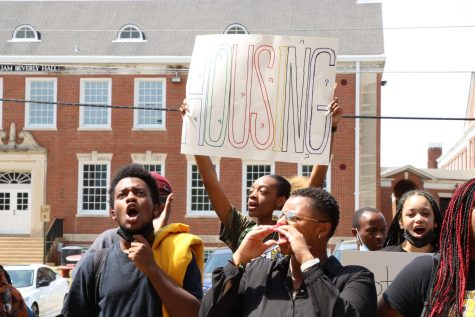IT’S TIME TO PROTEST
Students want changes to living conditions and transparency in the dissemination of ARPA funds
Students sit quietly in front of William Hooper Councill Hall in an organized protest regarding their living conditions and the amount of the disbursements distributed from the American Rescue Plan Act.
April 2, 2022
Thirty students gathered in front of the John Garrick Hardy Center around 11:15 on Wednesday, March 30, to protest what they claim to be “the misuse of COVID-19 funds and poor living conditions within the on-campus housing facilities.” As the minutes ticked by more students began to join.
The day began in unity and strong will as the protesters rallied in support of one another in ASU apparel while holding signs that read “#STATEFRAUD, ‘We Won’t Stay Silent’ and #CancelASU.”
However, days before the protest began, restlessness and an uneasiness dissipated throughout the campus as students started spreading the word and receiving fliers regarding an upcoming “Peaceful Protest,” seemingly in response to the recent disbursements of the American Rescue Plan Act of 2021 (ARPA) spring funds that began on March 28, 2022.
According to al.com, Alabama State University received $42,725,038 from the American Rescue Plan Act. The American Rescue Plan requires half of these funds to be used to provide direct financial relief to students. At the same time, the Department of Education expects the money will ultimately be used for educational purposes. In addition to funding provided under previous coronavirus relief legislation, these funds are already being used by colleges and universities across the country to serve students and ensure learning continues during the COVID-19 pandemic.
Once the funds began to be disbursed, a large percentage of Alabama State University students received a disclosed amount ranging from $570-$600 in total, which caused outrage
amongst students who felt as though “something doesn’t add up.”
One of those students is junior Brooklyn Alena, an outspoken student who made it known that she, along with Tray Barnett and Neveah Archer, were all organizers of the student protest.
“We started this protest to vocalize the issues and needs of the students,” Alena said. “We are demanding to see how the funds that Alabama State University received have been distributed. We have been told that the fund distribution list is already in the hands of higher-ups. It’s just not being presented to the students.
She continued.
“Yesterday, the SGA (Student Government Association) and SOS (Student Orientation Services) made a website trying to present the fund distribution breakdown, but we do not want web-based documentation. We want to see the actual document. In addition, we want the funds to be disbursed to aid in poor living conditions here on campus. We have mold, no heat or air, showers and ceilings leaking and two people placed in the group chat today said that they found rodents in Towers (C.J. Tower). Also, college work-study is not being paid like it is supposed to. We have only received January checks, so where is this money going? So there is a lot to discuss. We are not backing down.
Alena feels “it’s about way more than the money. It’s way deeper and they know it.” The biggest thing that I want to note is that Dr. Ross had not said anything and it had been over 48 hours.”
Although ASU has not issued an official response to student concerns, after recognizing the large outcry for answers, on March 28, the Student Government Association (SGA) President Gem Richardson sent out an email to the student body with a digital form link attached, urging students to utilize the Google form in order to “vocalize questions and concerns about the Cares Act” after the initial conversation of a protest arose.
However, Richardson’s email did not calm the crowd or the students who felt like they had not been dealt with fairly. SGA Treasurer Jeremi Moore (who is running for reelection) approaches the protestors in an effort to hear their concerns but also attempts to diffuse tensions by explaining how the funds were disbursed according to his conversation with ASU officials. However, the attempt to de-escalate the situation fell on deaf ears as students then began to get into a heated debate with Moore, claiming to have evidence of the university’s misappropriation of funds and demanding to see records and documentation of the disbursement in person.

“I feel like we allow ‘State’ to do things behind our backs, and they just expect us to deal with it because we have been here for so long,” said Kayjayy, a senior early childhood education major. “All we are doing is providing a path for the change that we want to see. If you want change, you have to be the change, use your right as a citizen to protest.”
“I do believe that this $500 that we just received is a portion of the 9 million that the school received for the fall semester,” said sophomore political science major Nevaeh Archer. “However, we have records that show that ASU was awarded $42 million on March 7. And while other schools on the list have received their Cares Act money, I find it unacceptable that we have not received ours yet. This is why we need to see the layout of how funds are disseminated, where they are going and how they are being used.
Archer continues.
“For example, the ‘Retool Your School money that was received in 2017 to ‘fix the Health Center’ has not been fixed yet. Simpson went viral for needing to be rebuilt, yet that is still an issue. Now we just received the ‘Retool Your School’ grant again, and they’re saying they want to add on to the John Garrick Hardy Center, so what happened to the money from the Health Center project or The Blue Meridian Project. Students have a right to know what the university is doing with the funds because we pay our tuition and keep the lights on here.”
Protesters marched from the Shuttlesworth Dining Hall holding their strikingly colored signs and brought attention to important issues that concern them greatly. They ended up at William Hooper Councill Hall, where they were ultimately met with a confrontation between the protestors and President Quinton T. Ross, Jr. Ed.D.
Sources close to the situation said the students were in the president’s office for at least an hour, conversing about their issues and listening to the university’s side of the story.
However, according to Alena, they were actually the ones who sought out an interview with Ross after protesting for over an hour.
Upon entering the building, she said the president’s staff was hostile and told the protestors that the president was not available but did take the contact information of Treyonous Burnett, a fellow organizer.
After being denied, they began exiting the building and at that point, they were abruptly called back to the office by Ross’ secretary. Once they returned to the office all cell phones and other devices were confiscated. Alena describes the scene as hostile and very tense, initially.
She continues to describe the meeting once they entered into the president’s office.
“We said hello to him when we entered his office, and we did not receive a response. He asked us what was going on and we dove right into our issues. We did not sugarcoat anything because we wanted to get to the bottom of this situation. For the first hour, we tried to explain our problems with the university and asked to see the documentation. It was a lot of back and forth. I mean, it was very intense.”

She continues.
“The first thing that Ross said was ‘first of all, hello.’ He then asked why we didn’t go to the SGA with our issues as they were the first line of defense for the student body, and then he disclosed that they had all the documents, which when we spoke with them, they denied having anything. I then asked him when was the last time he had stepped into Bessie Sears Estell Hall, Simpson Hall, or Martin Luther King Jr. Hall. Admittedly, he revealed that his issue was that the protest and social media posts brought the university bad publicity and a possible investigation.”
As the meeting began to cool down, according to Alena, she informed Ross that he was invalidating her as a woman, because he was only addressing Trey.
“In the end, he told me that I represented the gender well and I should consider running for SGA,” Alena said. “I am appreciative of the encounter because I think we got to know each other a bit better. He actually showed us his yearbook and some protests that he became involved with on campus. He revealed that we actually don’t have access to the $42 million yet, and the disbursements that went out this week were from the previous $9 million that they received, so we will be getting another check. They just do not know when. He even offered to help us structure the protest in a more effective way, but we kindly declined because this protest represents the students’ voices, but he did say that he wasn’t going to try and stop us. We are trying to grow our numbers, and a lot of people are scared to get arrested or reprimanded by the school.”
After the meeting, students seemed to have disbanded and were content with the results of the conversation that they had with Ross, but as promised they are “not backing down” and vow to keep any future conversations of wrongdoing going via social media and other gatherings.
“It’s most definitely important for students to protest because we need numbers. When you look at your environment and what you’re getting fed, where you stay and lay your head at night, you should know there is a problem, and it is up to the students to take action,” Alena said.
“If one thing can be said,” Alena said, “it is that the power of vocalizing concerns and meaningful protest was utilized and depicted an impactful statement to students and staff alike.”
“Lastly, I want people to know that we have many more gatherings planned, and we are rebranding the protest as #REFORM and #CLEAR COMMUNICATION,” Alena said. “Our goal isn’t to bash our HBCU, but simply to hold it to a higher standard. We need to have those conversations.
“Ross gave us emails and contact information to several different offices if we had further questions and we plan to use them. I actually told him that there should be no reason why my first time meeting him should be under these circumstances and he was shocked that I had never seen him in person before. I don’t want to run for SGA. I just want to help people. I want him to know that members of his administration are rude, hostile, and it makes him seem untouchable. Student-athletes and financial aid office workers don’t feel our pain. They get what’s due to them each month. Stay locked in because we have more planned for upcoming semesters so that we can transform ASU into the HBCU that we all deserve.”







